1.5mm Galvanized and Powder-coated Decorative Screen
Home » Specification & Inspection » Specifying Duplex Systems » Preparing HDG for Powder Coat
Preparing HDG for Powder Coat
Creating a duplex system of powder coating over hot-dip galvanized steel is relatively simple; however, proper surface preparation is critical for adhesion. One important element to understand is as the hot-dip galvanized coating weathers, different byproducts are on the surface requiring slightly different preparation for success. The specification ASTM D7803 contains detail on how to prepare the hot-dip galvanized surface for powder coating. The AGA offers, Preparing HDG Steel for Powder Coating, a package that includes an instructional guide booklet and step-by-step DVD video on how to prepare the hot-dip galvanized steel surface for powder coating.
Creating a successful duplex system of powder coating over galvanized steel requires the following seven steps:
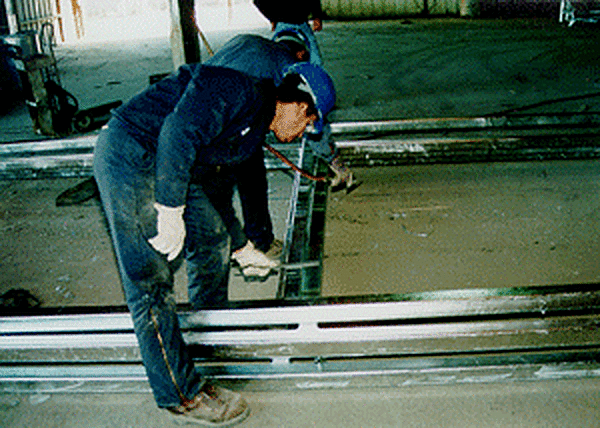

Communication between the fabricator, specifier, powder coater, and galvanizer is key prior to galvanizing. Early discussions can alleviate issues or concerns later in the process and facilitate the application of the duplex system. Also, it is important the galvanizer knows the part will be powder coated after galvanizing so precautions can be taken to avoid post-treatments that can cause adhesion issues.
In addition to avoiding post-treatment (quenching), the galvanizer will be alerted to watch for surface imperfections, namely dross and skimming inclusions that can inhibit powder coating adhesion. Though these imperfections are not cause for rejection on hot-dip galvanized parts, they present challenges when the part is duplexed. When the galvanizer is aware of the duplex specification, dross inclusions and skimmings can be removed or ground flat before powder coating.
Determine the condition of the surface
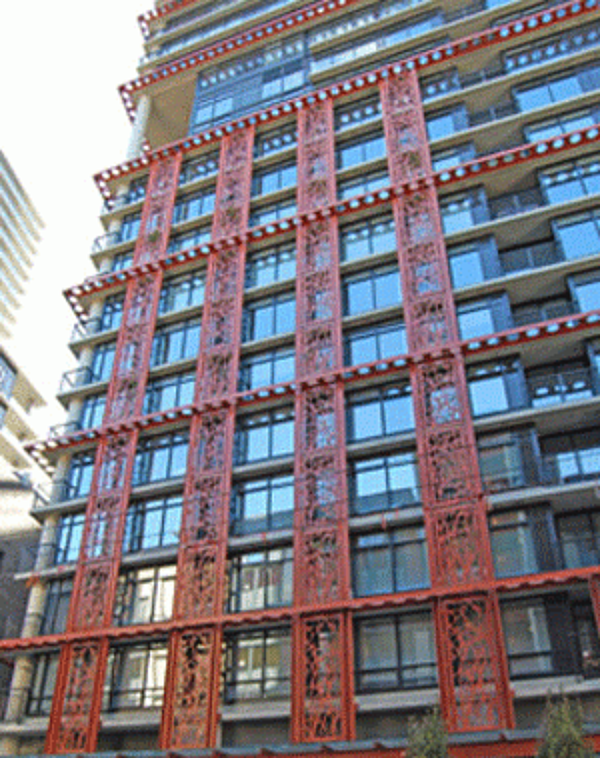
Determining the condition of the galvanized surface is critical to employing the proper surface preparation. As galvanized steel weathers and develops the zinc patina, different elements are present on the surface. Galvanized surfaces for powder coating are classified as newly galvanized or partially weathered. Properly identifying the surface is important because each requires different cleaning and/or profiling.
Newly Galvanized
Newly galvanized steel has been exposed to the atmosphere for a short time, typically less than 48 hours, and has few zinc compounds on the surface. The coating can be bright and shiny, indicating an all-zinc outer layer, or dull gray, indicating a zinc-iron intermetallic outer layer, or a combination of both. Regardless of the outward appearance, the common denominator is all newly galvanized surfaces have few or no zinc compounds on the surface, which simplifies the cleaning. Additionally, newly galvanized surfaces are smooth, so profiling is necessary to provide an anchor for the powder coating.
Partially Weathered
Partially weathered galvanized surfaces are typically present from two days to one year after galvanizing, depending on temperature and humidity conditions. Unlike newly galvanized surfaces, partially weathered galvanized steels have a build-up of zinc compounds and organic contaminants such as dirt, dust, oil, or grease. The organic compounds attached to the zinc coating will release from the surface over time, and thus, should be removed prior to powder coating. Furthermore, the zinc compounds zinc oxide and zinc hydroxide also must be removed. Partially weathered galvanized steel is the most difficult surface to prepare, but also the most common.
Clean the surface
After the surface condition of the galvanized piece has been identified, the part is ready to be cleaned. Newly galvanized and partially weathered surfaces require different levels of cleaning based on the surface contaminants. If the condition cannot be identified, follow the steps as if it were partially weathered.
The steps to cleaning the surface are:
- Remove bumps, runs, and drips (both newly galvanized & partially weathered)
- Remove organic materials (only for partially weathered)
- Rinse and dry (both conditions)
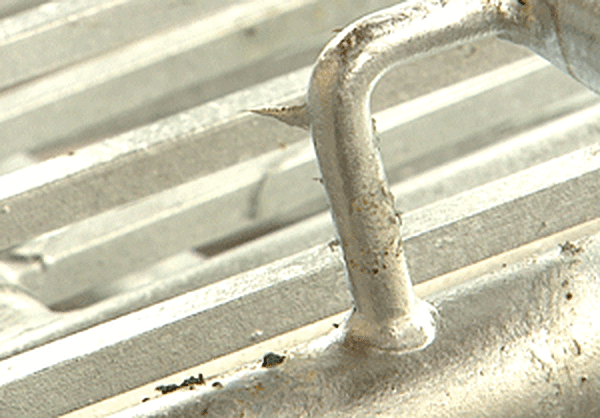
Removing bumps, runs, and drips which are deposits of excess zinc produced when the steel is withdrawn from the zinc bath is necessary before powder coating. These imperfections can protrude through the powder topcoat or create visual issues. To remove runs, drips, or bumps, the surface is ground or filed smooth and flat commonly accomplished with a hand grinder. Pure zinc is a soft metal, so caution must be taken to remove the excess zinc material without removing the underlying coating. The process of removing these excess zinc imperfections with a grinder can leave a dust or powder on the surface; therefore, they must be removed prior to cleaning organic compounds.
After the galvanized surface is smooth and free from bumps, runs, and/or drips, the next step for partially weathered surfaces is to remove organic contaminants. Organic contaminants are removed with an alkaline solution, acidic solution, or solvent cleaning.
Alkaline Solution
A mild alkaline solution, a mixture of ten parts water and one part alkaline cleaner, can remove all organics from the surface without damaging the galvanized coating. The alkaline solution can be brush applied or used with a power washer; however, if power washing the pressure must be held below 1450 PSI to ensure the zinc coating is not damaged.
Acidic Solution
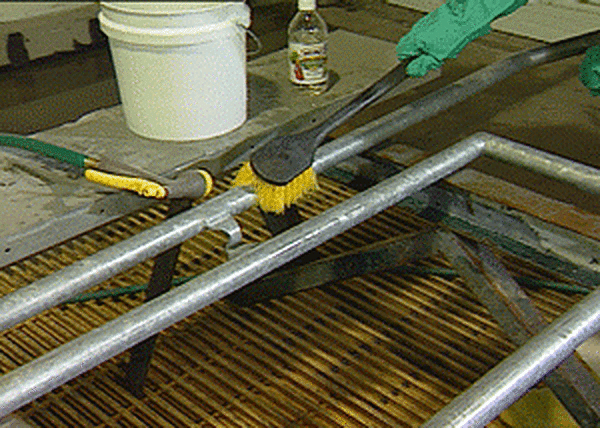
Organic contaminants can also be removed with a mild acidic solution, a mixture of 25 parts water to one part acid. The acidic solution will also slightly etch the zinc coating and leave the surface a dull gray color. Acidic solutions are usually brush applied and should be thoroughly rinsed off the part with fresh water no later than two to three minutes after application. It is good practice to rinse the part twice after using acidic solutions for cleaning.
Solvent Cleaning
Finally, solvent cleaning, applying solvents to the surface using a clean cloth, can be used. The cloth will pick up the organics, so it must be changed often to avoid re-depositing organics back onto the galvanized surface.
The final cleaning step for both newly galvanized and partially weathered surfaces is a rinse and dry to remove any remaining cleaning solutions or dust from grinding. If acidic cleaners were used to remove organic contaminants, a second fresh water rinse is recommended. After the rinse, the part should be completely dried before profiling. It is desirable to use heated drying to accelerate the complete removal of moisture from the surface.
Profile the surface
Once cleaning is complete, it is necessary to profile the surface for good powder coating adhesion. Profiling roughens all surfaces to provide an anchor for the powder coating. There are three different methods to profile the surface for powder coating: sweep blasting, zinc phosphate solution, or surface grinding.
Sweep Blasting
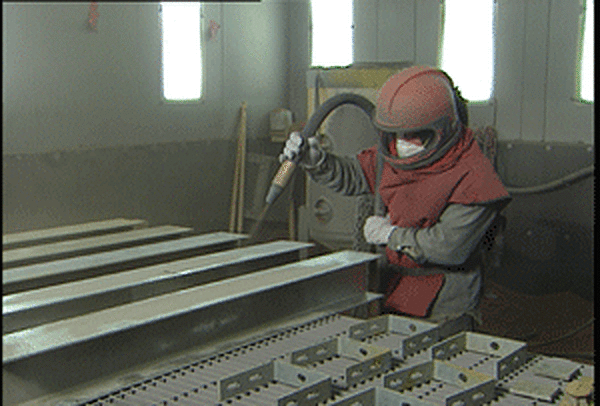
One method to profile the surface is to seep or brush blast the part per SSPC SP16. Sweep blasting is preferred over standard blasting to avoid damaging the soft zinc coating. Sweep blasting is angled onto the surface at 30 to 60 degrees, in contrast to standard blasting which uses a 90-degree angle. Additionally, the selection of abrasive material is important, as some are too abrasive for the zinc coating. The best practice is to utilize materials with a particle size of 200 to 500 micrometers and a Mohs hardness less than or equal to five.
Zinc Phosphate Solution
An alternative method of profiling is to passivate the surface with a zinc phosphate solution. Zinc phosphate reacts with the zinc on the surface to form a layer of zinc compounds tightly bonded to the surface. This layer protects the surface from oxidation and provides a rough profile good for powder coating adhesion. Zinc phosphate is applied by dipping the part in a tank of the solution followed by a fresh water rinse. The part must be fully dried, preferably heat dried, prior to powder coating.
Grinding
The final option for profiling the part for powder coating is to grind the surface with power tools such as grinders or sanders. Care must be taken to not completely strip the zinc coating, and afterward, the surface should be blown off with compressed air. The formation of zinc oxide on the surface will begin very quickly, so powder coating should be applied soon after this type of profiling.
Bake
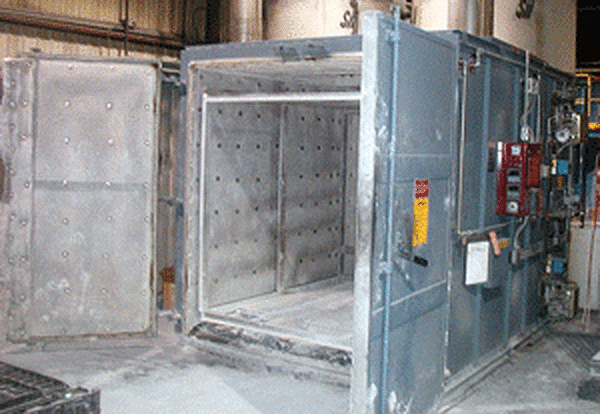
After the galvanized surface has been properly cleaned and profiled, the part is ready for baking. Water and air molecules can be trapped in the zinc coating, which can turn into pinholes and blisters (outgassing) in the powder coating if the part is not thermally treated prior to coating. The temperature of the baking oven should be 30 C above the temperature used to cure the powder. The part should be baked until the part reaches the oven temperature or a minimum of one hour. The part should then be cooled to a temperature that allows the application of the powder.
Powder Coat

Powder coating should follow baking as soon as possible so there is little or no time for zinc oxidation to begin. Consult the powder manufacturer for information on powder compatibility with zinc coatings. Apply the powder to the galvanized part in accordance with the manufacturers instructions. The powder is typically sprayed onto the galvanized surface. A good practice is to powder coat a sample piece of galvanized steel to check the overall coating appearance before coating the final piece.
Cure the Powder Coating
After the powder application, the part should be placed in the curing oven. The oven temperature should be set at the value recommended by the powder manufacturer. The curing time should follow the manufacturers instructions. Since the powder material contains no curing agent, it is critical to the powder coating process to provide an environment where the powder can bond to the galvanized coating.
1.5mm Galvanized and Powder-coated Decorative Screen
Source: https://galvanizeit.org/specification-and-inspection/specifying-duplex-systems/preparing-hdg-for-powder-coating
0 Response to "1.5mm Galvanized and Powder-coated Decorative Screen"
Post a Comment